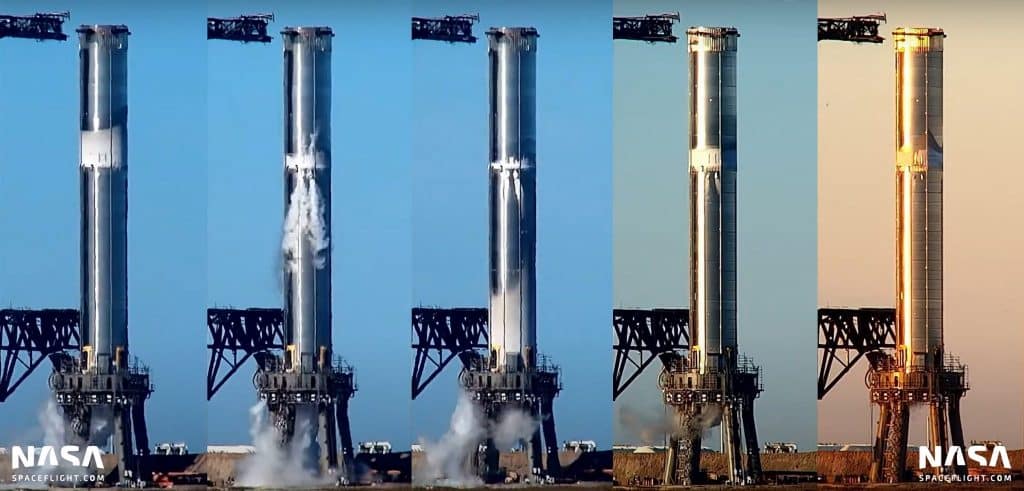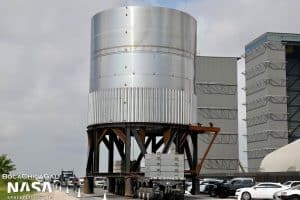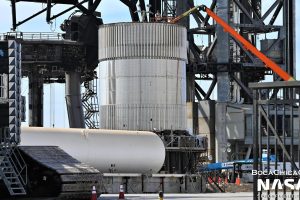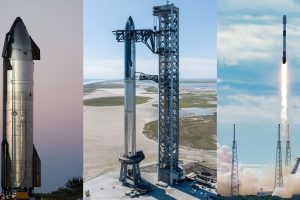Almost five months after SpaceX began the process of filling and testing the first custom-built propellant storage system for Starship, the largest rocket ever built, the company has finally begun to fill the fuel half of the ‘tank farm’.
SpaceX began delivering truckloads of liquid nitrogen (LN2) to the LN2 and liquid oxygen (LOx) sections of the tank farm in mid-September 2021, well before the farm was anywhere close to completion. In about a month, SpaceX accepted ~60 LN2 deliveries – enough to partially fill one of the farm’s seven cryogenic tanks. Instead of some operational purpose, that LN2 was likely used to clean and partially proof the farm’s three LOx tanks. Just two weeks later, the orbital tank farm received its first LOx deliveries.
At the time, mere days after the basic structure of the main tank farm storage system was effectively completed, most figured that it would take SpaceX about as long to clean, proof, and begin filling the farm’s two liquid methane tanks. That would not be the case.
SpaceX installed the second of the farm’s two vertical SpaceX-built cryogenic liquid methane (LCH4) tanks in mid-October 2021. All seven cryogenic tanks had ‘sleeves’ – designed to be filled with foam insulation – installed by the end of the month, effectively completing the farm’s basic structure half a year after assembly began. However, around the same time, SpaceX also installed two horizontal tanks that were also identified as LCH4 storage – giving the overall tank farm far more fuel storage than its oxidizer (LOx) tanks could match. Starship’s Raptor engines burn about 3.55 kilograms of LOx for every 1 kilogram of LCH4.
As work on the vertical LCH4 tanks appeared to slow to a crawl, it took until December 2021 for SpaceX to begin cleaning and proofing the farm’s horizontal LCH4 tanks with liquid nitrogen. By that time, a rough unofficial narrative had been constructed to explain the lack of progress on the farm’s fuel half. Namely, in an excellent Twitter thread, CSI Starbase made a strong case that SpaceX appeared to have designed the first orbital-class Starship tank farm – a compact and pleasingly symmetric set of eight vertical storage tanks – without taking into consideration rudimentary Texas regulations for the storage of liquid natural gas and methane. By all appearances, that conclusion was correct, as the farm was visibly violating several rules – namely the requirements that all LCH4 storage be surrounded by six-foot-tall retaining walls and that all associated plumbing not be situated under power cabling.
As it exists, the LCH4 side of the vertical tank farm violates both of those rules and it’s not obvious that there is actually enough space between the two vertical methane tanks to build a retaining wall with two feet of horizontal clearance. It’s possible that the situation is more complex and that SpaceX intentionally broke those rules or was pursuing an exception to them but the end result was that those vertical LCH4 tanks have yet to be finished, let alone cleaned or proof tested. Instead, SpaceX appears to have fully refocused on horizontal tanks and most recently tore down a dirt berm beside them and began preparing foundations for at least two or three more.
Those horizontal tanks appear to store about 1000 cubic meters (~35,000 ft^3) of LCH4, while the vertical tanks would have stored about 1800 m^3. To fully replace them, SpaceX will need approximately four horizontal tanks – two more in addition to the two already installed. Thankfully, SpaceX has finally begun filling the already installed tanks while it works to expand the methane farm, beginning with three truckloads on the very first day – February 13th, 2022.

To fill the two existing tanks, which may store enough methane to fuel a stacked Starship and Super Heavy about 4/5ths of the way, SpaceX will need around 40-50 more tanker deliveries. Since last November, SpaceX has completed more than 320 liquid nitrogen and 200 liquid oxygen deliveries – equivalent to about 6700 tons (~14.8M lb) of LN2 and 4200 tons (~9.3M lb) of LOx. If SpaceX maintains that average and focuses entirely on LCH4, the two horizontal tanks could be filled to the brim before the end of February.
Having a substantial amount of LCH4 stored at the orbital tank farm will finally allow SpaceX to attempt the first major wet dress rehearsals (WDRs) and, more importantly, the first full static fires with flightworthy Super Heavy booster prototypes. Of course, a tank farm with full supplies of LOx, LCH4, LN2, and their gaseous equivalents is also a necessity for the first orbital Starship launch attempt, which has most recently slipped from a target of mid-2021 to no earlier than (NET) Q2 2022, pending regulatory approval.





